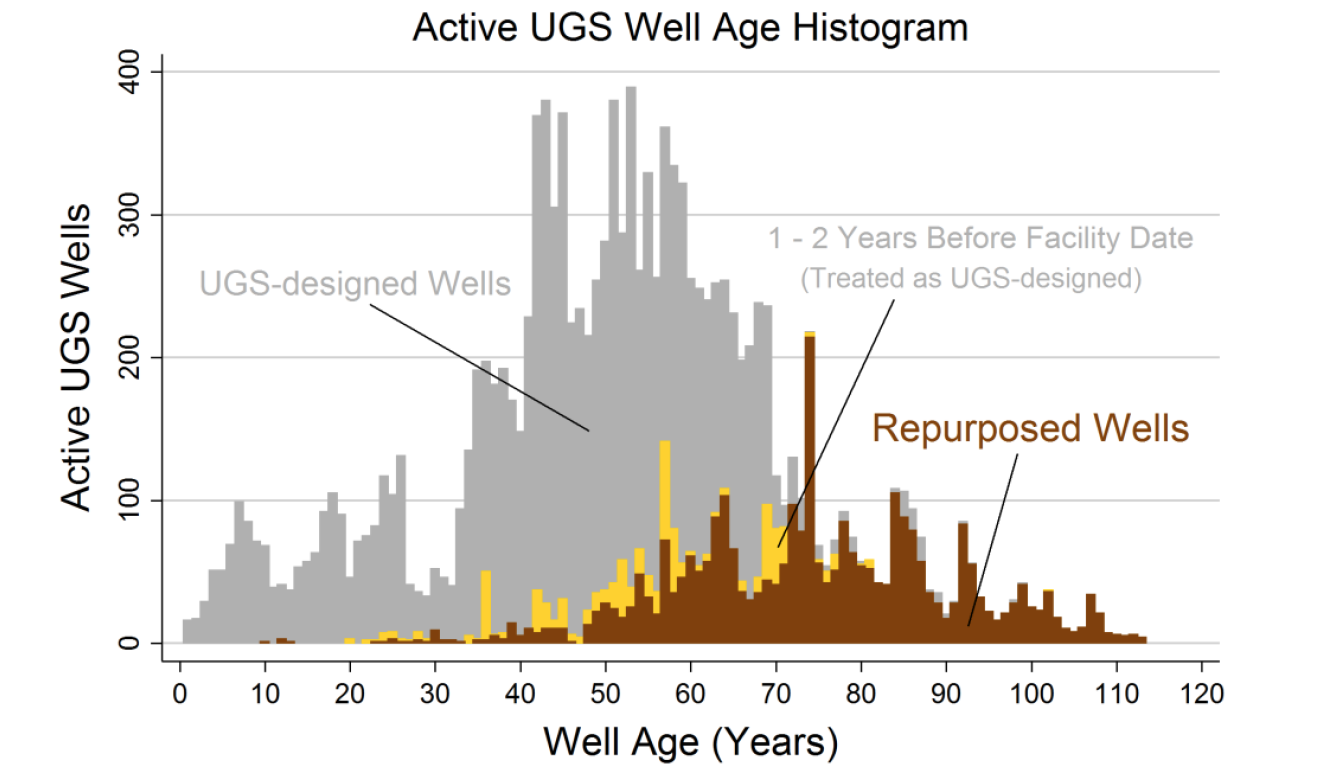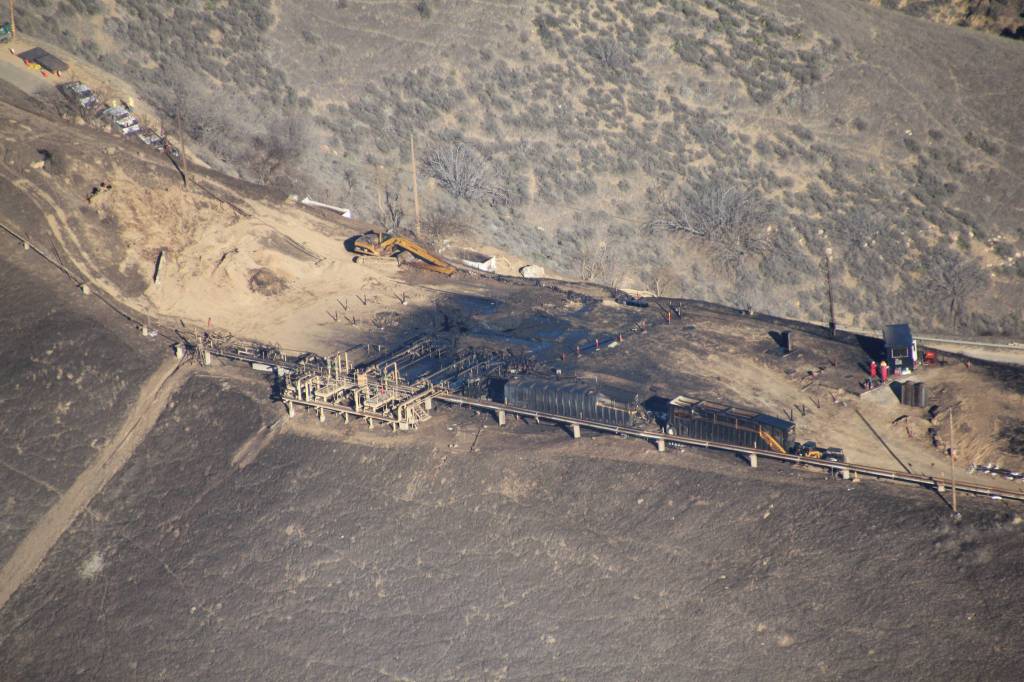NatureNet Science Update
The largest accidental release of greenhouse gases in U.S. history began October 23, 2015 with the blowout of an underground natural gas storage well in Aliso Canyon about 20 miles west of Los Angeles. By the time the well was capped 112 days later, more than 5 billion cubic feet of methane – equivalent to the annual emissions from 600,000 cars – had been released to the atmosphere. It was a disaster for public health, the environment, and the state of California’s energy supply.
Unfortunately, that’s not the only bad news. A new study by Conservancy NatureNet Science Fellow Drew Michanowicz and his colleagues at the Harvard T. H. Chan School of Public Health, Center for Health and the Global Environment shows that 1 in 5 active underground natural gas storage wells in the U.S. could also be vulnerable to such large-scale accidents because of obsolete well designs, like the one that lead to the blowout at Aliso Canyon.
Published today in the journal Environmental Research Letters, the study presents a first-of-its-kind national baseline assessment of underground storage wells in the U.S. and indicates the need for a better understanding of the risks associated with the obsolescence of aging storage wells. The paper also identifies regulatory data uncertainties, and is intended to aid policymakers, industry and citizens in prioritization and oversight for high risk wells and facilities.
“There could be a lot of potential Aliso Canyons out there,” said Michanowicz, lead author on the study. “It’s a matter of age, design and circumstance. We identified more than 2,700 active underground storage wells across the U.S. that, like the failed well at Aliso Canyon, were not originally designed for gas storage. They were designed for extraction only. Not extraction and injection of processed natural gas.”
These active, repurposed wells have a median age of 74 years, and some are more than 100 years old. Though well age alone may not be an issue, the structural integrity of gas storage wells is a least partially related to when they were built. This is because the materials, design, and construction techniques are reflective of the knowledge and understanding at that time. Therefore older wells are particularly likely to have certain design deficiencies like single failure points – the problem at Aliso Canyon – that do not reflect the engineering lessons learned over time.
Aliso Canyon & the Single Point of Failure
Today, modern oil and gas infrastructure is typically engineered to include substantial precautionary safety margins and redundancies to prevent or quickly seal blowouts and leaks. But not all the country’s underground natural gas storage is on par with modern standards because wells were built or repurposed (or both) for storage before those construction standards.
The well that failed at Aliso Canyon was originally drilled in 1954 for oil production. In 1972, it was repurposed for underground storage. The problem seems to be that because it was not originally constructed to store natural gas, only a single steel pipe separated the flow of gas and the outside rock formation. That meant the well’s passive structural integrity was vulnerable to a single point-of-failure along a portion of its casing. When part of the subsurface well casing failed, there were no redundancies or safety valves in place to prevent or minimize the blow out.
Today, according to the team’s first-order assessment, similar obsolete wells operate in 19 states across 160 underground gas storage facilities that encompass 51 percent of the total working gas capacity in the United States. The oldest wells are concentrated in Ohio, Pennsylvania, New York and West Virginia.
“As Aliso Canyon and other wellbore-related underground gas storage incidents have demonstrated, the vulnerability of even a single well presents a major risk to energy security, mitigation of climate change, and the safety and health of people who live near it,” notes Michanowicz.

What Now?
In the wake of Aliso Canyon, lawmakers created a commission to develop federal safety regulations for underground storage wells by June 2018. Unfortunately, there is a profound lack of the data and science on underground storage wells that people – policymakers, industry and citizens – need to make effective, data-driven risk-management decisions.
“Partly because no federal safety regulations currently apply to natural gas storage wells or their operations (now pending),” said co-author Jonathan Buonocore Harvard University T. H. Chan School of Public Health, Center for Health and the Global Environment, “very little aggregate information was available regarding these kinds of wells. After we identified this data gap, we realized we needed to build our own database to begin to assess this previously hidden hazard.”
The team developed a geodatabase of over 14,000 active UGS wells, using well and facility-level data from 29 individual states, the U.S. Energy Information Administration (EIA), and company system maps. Following recommendations from the Interagency Task Force on Natural Gas Storage Safety to phase out wells with only a single barrier of protection, the team began their assessment by calculating the prevalence and locations of active underground storage wells that were repurposed from hydrocarbon production.
1 in 5 of the 15,000 active underground gas storage wells in the US could be vulnerable to serious leaks.
They then referenced well construction dates with the typical construction practices from that era to identify which wells may be more likely to exhibit certain design deficiencies such as single casing protection.
“Another important finding was that older repurposed wells are present in facilities that had constructed new wells in the last decade. This variation of well vintage within facilities suggests that a range of risk management practices and integrity verification techniques are likely needed,” said co-author Sebastian Rowland, of the Harvard University T. H. Chan School of Public Health, Center for Health and the Global Environment
“Our study presents a census of active underground storage wells in the U.S. and identifies those that may be high-risk,” said Michanowicz. “Our research focused primarily on data availability and original well designs, so further research is needed to refine our understanding of active risk management practices at the state and operator levels. There’s still a lot of work to do, but at least now we know where to begin to prioritize efforts to prevent future Aliso Canyons.”
NatureNet Science Fellows’ Research and Climate Change
“This research is a good example of science to inform science-based policies to reduce risks to the public and the climate as our country transitions to cleaner energy,” said Joe Fargione, director of science for the Conservancy’s North America region.
Michanowicz’s work at Harvard University’s Chan School of Public Health is made possible by a Conservancy NatureNet Science Fellowship. NatureNet Science Fellows’ research confronts the two overarching challenges of climate change: 1) Halting climate change, and 2) Adapting to the change that is already underway.
Unique among early-career post docs, NatureNet, a partnership between the Conservancy and leading research universities around the world, is designed to push traditional conservation in new and necessary directions by integrating the Conservancy’s broad and long-standing scientific capacity in biology and ecology with engineering, materials science, nanotechnology, geography, economics, chemistry, and physics.
NatureNet brings leading early career scientists and engineers from diverse fields into the realm of problem solving at the interface of climate change, technology, and conservation to create a new generation of interdisciplinary conservation leaders who marry the rigor of academic science to real-world application in the field.




Cara,
I have been following news in Northern California, my home state, because of the extremes they have been experiencing in the last 10 years…regarding the weather among other things. Are you familiar with the issues Dane Wigington is taking on in his site geoengineeringwatch.com. It would mean a lot to me to get some various points of view.
I am extremely worried about the contamination of soils with what is being sprayed in our atmosphere under the guise of weather modification…and here in New England where I now live, the forests have been under stress since I first moved here in the 1970’s. We thought it was acid rain and I was working at a Nature Center at the time. Our efforts were to stop the pollutants coming east from midwestern power plants which we thought was contaminating the soil, weakening the immune systems of New England forests, and contributing to many diseases and vulnerabilities to invasive insects. Learning that water soluble aluminum nano particulates…sprayed into the atmosphere because they are reflective and remain aloft for days after spraying….blocking suns rays in an effort to cool global warming.
This spraying also has many side effects…including contaminating soils, destroying organically grown crops, wild plants (which are not genetically modified to resist aluminum uptake), forests, rivers, lakes, the ocean, plankton, fish, animals, and ourselves. All things that live under the sky…are being treated to this spraying on a regular basis. I myself have witnessed some incredible, unnatural clouds being laid out in the sky above us here in New England…and no one seems to be able to explain to me what is going on and why and if there is dangerous fall out from this continuous spraying from high flying air planes.
After looking into this issue and listening to many talks and presentations and writings of Rosalind Peterson and Dane Wignington, both citizens of Northern California and responsible people, I think it is one of the MOST important issues of our time, and the least reported and exposed so that our citizenry has some information about what is being done to us and our world without our knowledge nor permission.
If you check out the website, geoengineeringwatch.com, could you let me know what you think. I am earnestly looking for a wider perspective on this issue….and what we citizens can do about it.
Sincerely, Carol Hart